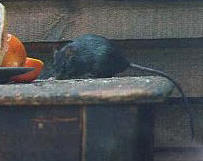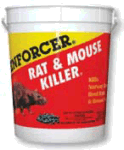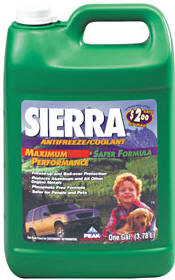Last
updated 7/22/07
 There
are several types of rat poisons available. The traditional products
(and best known) are called anticoagulant rodenticides and those are
ones that I will discussed here. If you intend to use a
rodenticide I encourage you to choose this type over others as there
is a readily available antidote for the anti-coagulant rodenticides.
There
are several types of rat poisons available. The traditional products
(and best known) are called anticoagulant rodenticides and those are
ones that I will discussed here. If you intend to use a
rodenticide I encourage you to choose this type over others as there
is a readily available antidote for the anti-coagulant rodenticides.
Everyone should be aware of the signs
of rat poisoning, particularly if your pet travels with you to
places outside the home where bait may be left out.
Symptoms

 Most
of the time external bleeding is not obvious and one
only notices the pet is weak and/or cold. If one looks at the gums,
they are pale. Sometimes bloody urine or stool is evident or nose
bleeds may be seen. Signs of bleeding in more than one body
location are a good hint that there is a problem with blood
coagulation and appropriate testing and treatment can be started.
Most
of the time external bleeding is not obvious and one
only notices the pet is weak and/or cold. If one looks at the gums,
they are pale. Sometimes bloody urine or stool is evident or nose
bleeds may be seen. Signs of bleeding in more than one body
location are a good hint that there is a problem with blood
coagulation and appropriate testing and treatment can be started.
Anticoagulant rodenticides cause
internal bleeding.
A poisoning victim will show weakness and pallor but bleeding will
likely not be obvious externally.
Anticoagulant rodenticides do not produce signs of poisoning
for several days after the toxic dose has been consumed.
How Does Rat Poison Work?
In cases of poisoning one would expect
symptoms to be nearly immediate, but in the case of anticoagulant
rodenticide poisoning it takes several days to deplete Vitamin K.
After that, even the smallest of jostles and traumas can lead to
life-threatening bleeds.
The anticoagulant rodenticides tie-up Vitamin K and
prevent clot formation. This means that as soon as one’s active
Vitamin K reserves are depleted, there can be no meaningful
blood clotting.
Testing -- Blood clotting tests of the intrinsic
and extrinsic pathways are called the PTT (“partial thromboplastin
time”) and PT (“prothrombin time”) respectively. If both of these
pathways show disruption, rat poisoning is the most common cause.
Not all veterinary hospitals have the capability to test PTT and PT
in hospital. Many hospital must send these tests off and won't
get results back for 24 hours. Most of these hospitals will
perform a "clot time" (and there are various methods of doing this),
if rat poison is suspected.
Therapy -- If the
patient has only just ingested the poison, he or she may be made to
vomit it up. You can give Hydrogen peroxide by mouth to help induce
vomiting.
Give full strength (3%) hydrogen peroxide by mouth at a dosage
of 1 tablespoon (15cc) per 15 to 20 pounds of body weight, or syrup of
ipecac (follow label directions)
Your veterinarian might use cathartics
and adsorbents to prevent the poison from entering the patient’s
system. Still, it is prudent to use the antidote anyway. Certainly,
if there is evidence that the patient is bleeding, the antidote
obviously is required.
The antidote for Rat Poison is simply Vitamin K.
Vitamin K is generally started as an
injection and when the patient is stable. Tablets are prescribed.
The human formulation, available at most drug stores by
prescription, is a 5 mg tablet. The veterinary strength is a 25 mg
tablet. Blood transfusions may be needed to stabilize a patient who
has suffered significant blood loss if the poisoning was not found
until later.
There are different classes of anticoagulant rodenticides and they
remain in the body for several weeks. It is hard to know when to
discontinue therapy, especially if the particular rodenticide is not
known. After a couple of weeks of therapy, medication is
discontinued; 48 - 72 hours later another clot time is performed.
If there is still rodenticide in the patient’s system, the clot time
will be abnormal but the patient will not yet have started to bleed.
The results of the test will tell the veterinarian whether or not
another couple of weeks of Vitamin K are needed.
There is no point to doing a clot time test while the
patient is still taking Vitamin K. The test must be done 48
-72 hours after discontinuing the medication.
It
is very important to return for the recheck a clot time on
schedule. Waiting an extra day or two will allow internal
bleeding to recur.
The Pet that Eats the Poisoned
Rodent -- I am commonly asked about the risk to dog who
eats a rodent that has been poisoned with rat poison. The rodent
might have been poisoned, already died, or be in the process of
dying when the dog finds it. The fact is that when one is talking
about the newer generation rat poisons, the risk is very real. A
greedy rat can eat enough poison to kill 20 rats before he starts to
feel sick and if a dog or cat eats the rat, the poison is
transferred.
If you think your pet might have been
poisoned by rat poison, I recommend contacting your local
veterinarian immediately. It will be much cheaper to be "safe
rather than sorry" and by waiting to see if he/she shows signs of
poisoning, you may cause your pet undue suffering and your
pocketbook an excess expense.
Antifreeze
Poisoning
Poisoning
by antifreeze, or ethylene glycol, is one of the most common small
animal toxicities. Every year, by some estimates,
about 10,000 dogs and cats are victims of accidental poisoning by
automobile antifreeze. Antifreeze is extremely toxic --most brands
of commercial antifreeze consist of 95 percent ethylene glycol.
Even a few licks of this sweet-tasting liquid can be fatal to a cat
or dog. (For a medium sized dog, ingestion of about 2 ounces (3-4
tablespoons ) is toxic.) Many people aren't aware that another
source of antifreeze are the decorative "snow globes" glassware. The
liquid in the these displays contain 2% antifreeze and are very
toxic as well.
Snow Globes are a source of antifreeze
poisoning!
Both cats and dog are attracted to the smell and taste of
ethylene glycol. Remember to watch your driveway for a puddle of
greenish-colored liquid. Your car can leak coolant at any time.
Flush the area with plenty of water and don't delay locating and
fixing the leak. Another method of quick clean-up is to spread cat
litter on the spill, clean up with rags (which are bagged
immediately) and then rinse. Antifreeze will biodegrade in the
environment, but it takes weeks or months to do so, so removing the
spill is absolutely essential.
Poisoning classically proceeds through
three stages:
Stage 1: Absorption after
ingestion is rapid and initial signs occur within 30 minutes to 12
hours. Ethylene glycol is an alcohol; hence during the initial phase
the animals appear "drunk" and consequently exhibit many of the
classical signs associated with alcohol intoxication: staggering,
stumbling, and in-coordination. Vomiting, nausea, extreme thirst,
and frequent urination are also observed. Some animals simply sleep
through this period and owners are not aware that poisoning has
occurred.
Stage 2: At the end of
the first phase, the clinical signs resolve and the animal appears
to have recovered. The second phase of intoxication occurs 12 to 24
hours after poisoning. The heart rate and breathing rate are rapid,
but this is rarely noticed by owners.
Stage 3: Unfortunately,
most dogs and cats poisoned with antifreeze are not recognized until
the third stage. Ethylene glycol is converted by the liver to more
toxic substances (metabolites) that are responsible for the majority
of injury to tissues including the kidney, liver, lungs, and heart.
Signs of kidney failure include severe depression, vomiting, and
diarrhea. The kidneys stop producing urine and toxins normally
excreted by the kidney build up in the body, resulting in a
life-threatening situation. Once metabolism of the ethylene glycol
has reached a certain point, there is no way to stop it. The body
creates crystals (mainly in the kidneys) that are insoluble, and
there is no way to remove them from the body.
Getting the dog to a veterinarian is critical within the first
9-12 hours following ingestion. After that length of time, the liver
will have already begun metabolizing the ethylene glycol into
substances that cause kidney failure and ultimately death.
Symptoms of
Antifreeze Poisoning:

 One
step owners can take to prevent a potential
tragedy from befalling their pets is to use a
propylene-glycol-based antifreeze
One
step owners can take to prevent a potential
tragedy from befalling their pets is to use a
propylene-glycol-based antifreeze
 There
are several types of rat poisons available. The traditional products
(and best known) are called anticoagulant rodenticides and those are
ones that I will discussed here. If you intend to use a
rodenticide I encourage you to choose this type over others as there
is a readily available antidote for the anti-coagulant rodenticides.
There
are several types of rat poisons available. The traditional products
(and best known) are called anticoagulant rodenticides and those are
ones that I will discussed here. If you intend to use a
rodenticide I encourage you to choose this type over others as there
is a readily available antidote for the anti-coagulant rodenticides.
